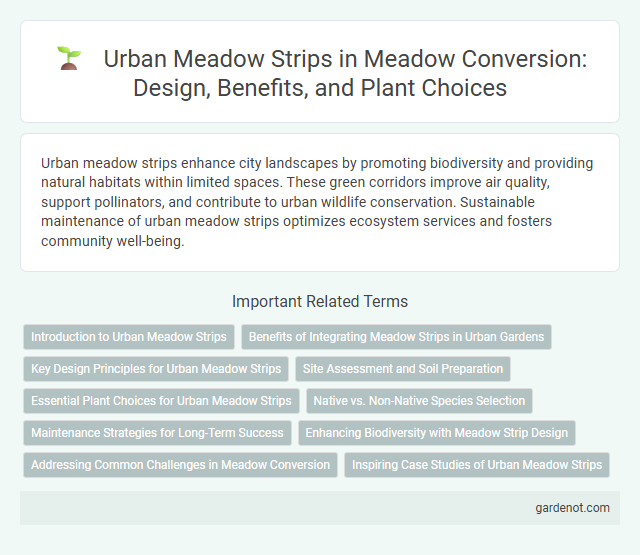Urban meadow strips enhance city landscapes by promoting biodiversity and providing natural habitats within limited spaces. These green corridors improve air quality, support pollinators, and contribute to urban wildlife conservation. Sustainable maintenance of urban meadow strips optimizes ecosystem services and fosters community well-being.
Introduction to Urban Meadow Strips
Urban meadow strips are narrow bands of perennial wildflowers and grasses integrated into city landscapes to enhance biodiversity and ecological health. These strips support pollinators like bees and butterflies while improving air quality and reducing urban heat effects. Incorporating native plant species in urban meadow strips promotes habitat connectivity and sustainable green infrastructure.
Benefits of Integrating Meadow Strips in Urban Gardens
Integrating urban meadow strips in gardens enhances biodiversity by providing habitats for pollinators such as bees, butterflies, and other beneficial insects, crucial for ecosystem balance. Meadow strips improve soil health through natural nutrient cycling and reduce maintenance costs by minimizing mowing and irrigation needs. These green corridors also mitigate urban heat island effects, contribute to air purification, and create aesthetically pleasing, tranquil spaces within city environments.
Key Design Principles for Urban Meadow Strips
Urban meadow strips require strategic planting that prioritizes native, low-maintenance species to enhance biodiversity and provide continuous seasonal interest. Soil preparation is essential, using nutrient-poor substrates to discourage aggressive grasses and promote wildflower growth, while maintaining proper drainage to prevent waterlogging. Design should also consider pedestrian pathways and visual accessibility to integrate the meadow seamlessly into urban environments and encourage community engagement.
Site Assessment and Soil Preparation
Urban meadow strip conversion requires thorough site assessment to evaluate sunlight exposure, soil pH, nutrient levels, and existing vegetation. Soil preparation involves removing turfgrass, loosening compacted soil to improve aeration, and incorporating organic matter to enhance fertility and drainage. Proper soil grading and weed control are essential to establish a healthy meadow ecosystem that supports native wildflowers and pollinators.
Essential Plant Choices for Urban Meadow Strips
Native grasses such as Festuca rubra and Deschampsia cespitosa thrive in urban meadow strips, offering resilience and low maintenance. Incorporating wildflowers like Achillea millefolium and Centaurea nigra enhances biodiversity and provides vital nectar sources for pollinators. Selecting drought-tolerant species with deep root systems supports soil stability and urban heat mitigation in these green corridors.
Native vs. Non-Native Species Selection
Urban meadow strips thrive when prioritizing native species, which support local ecosystems by providing essential habitats for pollinators and wildlife. Non-native species often compete aggressively, potentially disrupting ecological balance and reducing biodiversity in these green corridors. Proper species selection enhances ecosystem resilience, promotes native flora regeneration, and maintains the natural character of urban landscapes.
Maintenance Strategies for Long-Term Success
Urban meadow strips require carefully planned maintenance strategies to ensure long-term ecological and aesthetic benefits. Regular mowing at specific times preserves native plant diversity while preventing invasive species dominance. Periodic soil assessments and adaptive management practices enhance plant resilience and support sustainable urban biodiversity.
Enhancing Biodiversity with Meadow Strip Design
Urban meadow strips optimize biodiversity by incorporating native wildflowers and grasses that support pollinators like bees and butterflies. These strips create essential habitats for urban wildlife, promoting ecological balance and resilience in city environments. Strategic planting and maintenance of diverse species enhance soil health and reduce the need for pesticides, fostering a sustainable urban ecosystem.
Addressing Common Challenges in Meadow Conversion
Urban meadow strip conversion often faces challenges such as soil compaction, invasive weed species, and limited sunlight due to surrounding structures. Effective strategies include soil decompaction through aeration, selective weeding to promote native biodiversity, and planting shade-tolerant wildflower species. Regular maintenance and community engagement further enhance the ecological and aesthetic benefits of urban meadow strips.
Inspiring Case Studies of Urban Meadow Strips
Urban meadow strips transform narrow city spaces into vibrant ecosystems, boosting biodiversity and supporting pollinators like bees and butterflies. Notable case studies, such as the London Queen Elizabeth Olympic Park and New York City's High Line, showcase how integrating native wildflowers and grasses enhances urban aesthetics and improves air quality. These projects demonstrate measurable benefits in community well-being and urban resilience through sustainable landscaping.
Urban meadow strip Infographic

 gardenot.com
gardenot.com